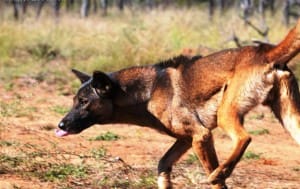 SOUTHERN producers seem largely unaware of the scale of the wild dog problem that is coming their way, Australia’s national wild dog program coordinator Greg Mifsud has warned.
SOUTHERN producers seem largely unaware of the scale of the wild dog problem that is coming their way, Australia’s national wild dog program coordinator Greg Mifsud has warned.
Escalating wild dog populations have been traumatising sheep and cattle producers in the north for well over a decade and in some cases have forced producers off the land altogether.
The threat is gradually pushing further south, with Mr Mifsud admitting to being surprised himself to learn just how many dogs have now been sighted in southern areas of South Australia this year.
He said he was equally surprised by the level of complacency he encountered about the growing threat at the lamb industry’s major bi-annual conference, Lambex, held in Adelaide in July.
“I was perplexed at that Lambex conference about the apathy to the wild dog issue,” he says.
“When I got back and started doing some research, I found out that there had been 20 dogs shot at Clare (in South Australia) alone.
“We had previously thought only about 2-3 had been shot there.
“So we are talking halfway from the Flinders Ranges to the Adelaide Hills. If they get established in the Adelaide Hills they will never get rid of them.”
If any of the 900 or so delegates who attended Lambex arrived at the conference with little understanding of just how devastating wild dogs can be, a shock and awe presentation by Queensland stud Merino breeder Karen Huskisson ensured no one left lacking that knowledge.
Showing confronting, bloody images of the victims of wild dog attacks on her own flocks at Wattle Downs to convey the stark reality of the issue, she warned her southern counterparts to take a proactive, coordinated and community-wide approach to countering the problem.
In one year alone, she explained, Wattle Downs lost 300 stud ewes, which amounted to hundreds of thousands of dollars worth of losses both for that year and in lost production going forward, as well as causing great mental strain.
However, the Huskisson’s story also had a silver lining, in that it has demonstrated that with the help of old fashioned community spirit, the fight against dogs is winnable.
The conference heard how a combination of using Maremma guardian dogs, coordinated baiting with other local producers and proactive shooting and trapping campaigns have successfully helped to rid Wattle Downs of wild dogs in recent years.
Electronic tracking shows how far dogs travel
In his presentation to the same conference, Mr Mifsud told a story to illustrate how far individual dogs can travel, and to underline the point that no sheep producer should believe they are insulated from the threat.
He explained the results of research in which a wild dog was fitted with an electronic tracking collar near Charleville when it was 10 months old.
Tracking showed that the young dog travelled 630km in four weeks to Collarenebri in NSW, where it then spent a further seven months on a sheep property until it was located and destroyed.
What was remarkable about that story was not just the confirmation it provided about how much ground single dogs can cover, but the fact that the landholder who owned the property at Collarenbri where it had settled sincerely believed he did not have any dogs on the property. The landholder was astonished when researchers shot the radio collared dog on the property, but was even more concerned when workers shot a female dog in the same location a week later.
Mr Mifsud said dogs were now cropping up in places where they had not been seen for decades and people had no idea what to look for or how to deal with the problem.
“You’re talking about generations of farmers that haven’t had dogs on their properties for 50, 60 or even 100 years,” he said.
“They have been insulated (from dogs) for so long, I don’t think they know what is about to hit them.
“They have more to lose down there I think, it is better country, there is more productivity in terms of sheep and wool, and I don’t think they realise what is coming yet.”
Mr Mifsud said various factors caused gaps in control efforts that allowed dogs to keep filtering through into livestock production areas, including properties that chose not to participate in control programs such as cattle operations, organically certified businesses that cannot use baits, absentee landlords,, tourism operations and indignenous lands.
He said producers at Hawker and Orroroo midway between the Flinders Ranges and Adelaide, which had not had a history of wild dogs for a long time but was now becoming a problem area, were starting to work collectively.


If anybody should know how a dingo works it’s me, because I have owned a dingo for 12 years. They are the most intelligent and cunning mongrels you can ever imagine. They can be the most destructive creatures that you will ever find and you have to study their habits to partly understand what they can do.